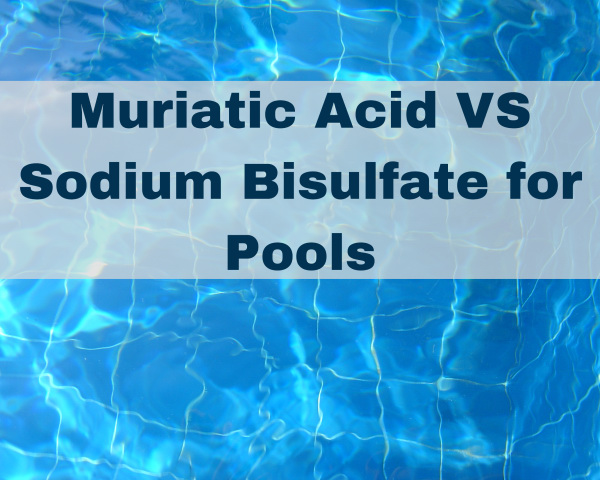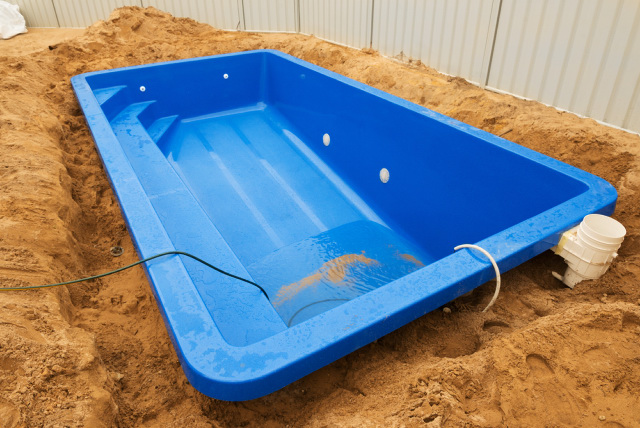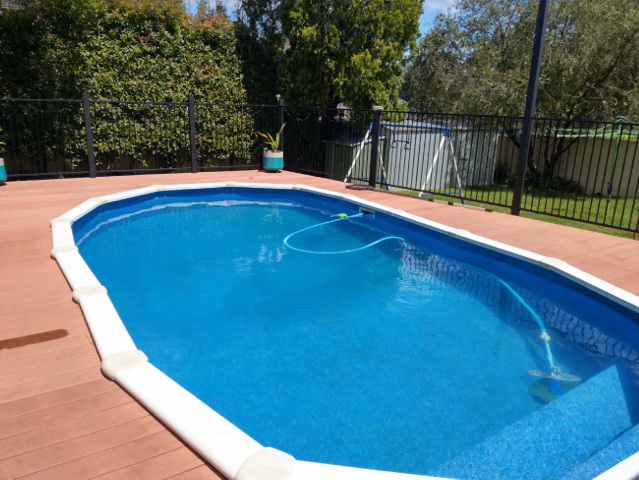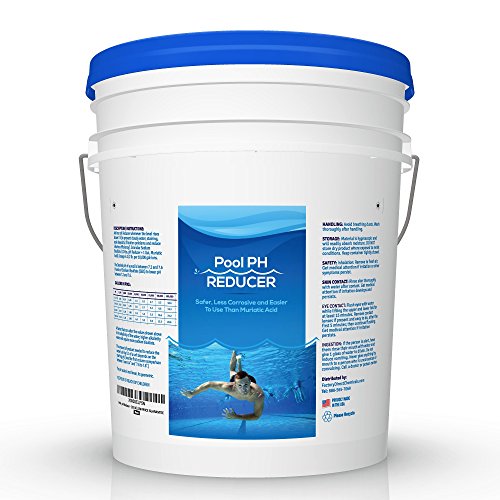Perhaps you’ve recently tested your pool water chemistry and noticed that the pH and alkalinity are too high, so you’re trying to find the best ways to lower them. In this article, I’ll be helping you compare and contrast the two most common chemicals used to lower pH and alkalinity, muriatic acid and sodium bisulfate, so you can decide which option is best for you.
Both muriatic acid and sodium bisulfate are good options for lowering the pH and alkalinity in your pool, though each has its pros and cons. Muriatic acid is more efficient but dangerous to handle and sodium bisulfate is safer but more expensive. Which option you choose will ultimately depend on your needs.
Let’s first take a look at what these chemicals are individually so that you can have a better sense of the comparisons I’ll be discussing later on.

Article Contents
What is Muriatic Acid
Muriatic acid is a highly corrosive and hazardous chemical that is the diluted version of hydrochloric acid.
Muriatic acid appears most often as a liquid acid that is commercially produced and sold in 1-gallon jugs. They are typically sold in both a 30% concentration version (at pool stores) and a 15% concentration version (at hardware stores).
Though used to quickly lower the pH and alkalinity of pool water, muriatic acid is also used as a household cleaning solution, especially when it comes to cleaning stains and grout.
Related Reading: What Is Muriatic Acid for in a Pool?
What is Sodium Bisulfate
Sodium bisulfate, also known as dry acid, is a safer and less corrosive alternative to muriatic acid.
Sodium bisulfate appears in granular form and is commercially produced and typically sold by the bucket. It’s available only in 93% concentration.
Like muriatic acid, sodium bisulfate lowers pH and alkalinity and is also used in household cleaning products and other applications.
Related Reading: Using Sodium Bisulfate to Lower pH & Alkalinity in Pool
Is pH Down or pH Decreaser Sodium Bisulfate?
pH Down and pH Decreaser is an umbrella term, most often used in the pool and spa industry, that includes any product that can lower the pH of pool or spa water. In this sense, pH reduction products include both muriatic acid and sodium bisulfate. Both can be used to lower the pH and total alkalinity of pool water.
Cost of Muriatic Acid
The cost of muriatic acid depends on the amount and concentration of the product. On average, a gallon of muriatic acid costs roughly $20 to $25.
For a general idea, here are some of the most common muriatic acid products on the market.
| Name | Pros | Cons |
| Acid Blue Muriatic Acid – Swimming Pool pH Reducer Balancer – 1 Gallon | Vapor reduction technology reduces 90% of harmful vapors that come with traditional muriatic acid Does not permeate through plastic bottles Fast and effective pH and alkalinity reduction Works in both pools and spas (hot tubs) | The difference between this and traditional muriatic acid is not very noticeableStings the eyes even though fumes are reduced |
| Sunbelt Chemicals 1 Muriatic Acid | Very quick and efficient (works in under 15 minutes) Effective for a variety of surfaces and household products Fast and effective pH and alkalinity reduction Works in both pools and spas (hot tubs) | Fumes can be quite intense (a mask is recommended) |
Cost of Sodium Bisulfate
The cost of sodium bisulfate, like that of muriatic acid, depends on the amount and concentration of the product. The average cost of sodium bisulfate for a 2-pound bucket is $18.
Here are some of the best-reviewed products on the market right now:
| Name | Pros | Cons |
| pH Down | Pool & Hot Tub Spa pH Reducer | Biodegradable and non-toxic Compact and easy to store Fast and effective pH and alkalinity reduction Works in both pools and spas (hot tubs) | The container doesn’t state the concentration of sodium bisulfate versus other ingredients. Weaker therefore more expensive than muriatic acid. |
| EcoClean Pool PH Reducer | The bucket is covered with a bag so it can be closed after use Good value for its price Fast and effective pH and alkalinity reduction Works in both pools and spas (hot tubs) | Doesn’t come with clear instructions on how to use it. Weaker, therefore, more expensive than muriatic acid. |
Which is Cheaper? Sodium Bisulfate or Muriatic Acid?
Muriatic acid is cheaper per dose to lower pool pH and total alkalinity. Muriatic acid costs $7 per dose whilst sodium bisulfate costs $9 per dose. This is based on reducing pH from 7.9 to 7.5 in a 17,000 gal (77,284 L) pool.
Because it’s difficult to compare a liquid acid and a granular acid that comes in different concentrations, we should look at this from a cost-per-dose perspective to see how much each would cost when they’re both trying to lower the pH. To do this, we’ll be using a standard pool size, which averages about 17,000 gallons (77,284 L).
In this case, say we’re trying to lower the pH from 7.9 to 7.5. This requires approximately 12 ounces (354 mL) of 31% strength muriatic acid or 16 ounces of sodium bisulfate granules. Assuming the cost of muriatic acid and sodium bisulfate is $20 per gallon and $18 for 2 pounds respectively, that means we’ll be spending $7 on muriatic acid and $9 on sodium bisulfate.
| Cost | Cost Per Dose | |
| Muriatic Acid (31%) | ~$20 per gallon | $7 |
| Sodium Bisulfate | ~$9 per lb | $9 |
From this, you can see that to lower the pH of a 17,000-gallon (77,284 L) pool from 7.9 to 7.5 will require $7 if you’re using muriatic acid and $9 if you’re using sodium bisulfate. Hence, muriatic acid comes out as the cheaper of the two.
Is Sodium Bisulfate or Muriatic Acid Better for Pool?
For most pools, muriatic acid is probably the better option as it doesn’t add sulfates to the water. Additionally, muriatic acid works faster and is cheaper per dose.
Sulfates
Per its namesake, a major component of sodium bisulfate is sulfates. This means that every time you add sodium bisulfate to your pool water, you increase the sulfate concentration in the water. Usually, if the sulfate level in your pool water exceeds 300 ppm, the water will start to attack and corrode concrete pool surfaces, metal components (including saltwater generators), and vinyl pool liners.
As a general rule, you add about 10 ppm worth of sulfates for every pound of sodium sulfate you use in a 10,000-gallon (45,461 L) pool. As mentioned in our earlier example, it takes roughly a pound of sodium bisulfate to lower the pH by about 0.4. This means that to lower the pH any more will mean additional sodium bisulfate and therefore, more sulfates to your pool water.
If you need to make further adjustments, the sulfates can easily pile up and, because they’re quite difficult to remove, you’ll likely see the effects of the sulfates on your pool much sooner than you’d expected.
Safety
Is sodium bisulfate or muriatic acid safer?
Both sodium bisulfate and muriatic acid are dangerous chemicals and should be handled with care. Muriatic acid is more dangerous though.
Since it is in liquid form, it’s easier to spill. It also creates toxic fumes. Additionally, it’s stronger and will cause more damage to surfaces or body parts if it’s spilled or splashed.
When using either chemical, acid-resistant gloves, long sleeve clothing, and safety glasses should be used.
Which Pools Should Use Sodium Bisulfate?
Because the sulfates from sodium bisulfate are notorious for damaging concrete surfaces once they’re above 300 ppm, it’s safer to use sodium bisulfate in either a fiberglass or vinyl pool.
Use for a Fiberglass Pool
Because fiberglass is constructed using small glass threads, polyester resin, and weather-resistant gel, it’s much less prone to damage caused by sulfates. It doesn’t react as concrete does.

Use for a Vinyl Pool
Vinyl pools are characterized by having a sheet of vinyl between the water and the pool structure. An example is some inground pools and many above-ground pools.
Though the floor typically has a base of sand or a cement-like substance, and the walls are made with galvanized steel or thermoplastic, the vinyl itself protects these materials from the water. This means the rest of the pool structure is much less likely to be damaged by the sulfates from dry acid.

Related Reading: Which Chlorine to Use for Vinyl Liner Pools?
Which Pools Should Use Muriatic Acid?
Though durable and versatile, gunite pools are highly vulnerable to sulfate damage, thus the best option is to use muriatic acid. The reason is that gunite is built using a rebar framework that is covered in a concrete and sand mixture.
Concrete is vulnerable to damage spawning from high sulfate concentrated water. That’s why it’s best to avoid sodium bisulfate and use muriatic acid instead.
How to Lower pH with Sodium Bisulfate
Here, I’ll be providing you with a quick guide on using sodium bisulfate to lower the pH in your pool.
- Test the pH and alkalinity of your pool water so that you know how much you need to lower it;
- Follow the manufacturer’s directions to see how much sodium bisulfate you’ll need;
- Pour the product into the water near the return jets and deepest end of your pool, while keeping your pumping running;
- Let your pool’s filtration system circulate and dissolve the product in the water;
- Retest the water chemistry within 24 hours and repeat if necessary.
How to Lower pH with Muriatic Acid
Here’s how to use muriatic acid to lower the pH in your pool.
- Test the water chemistry to see how much you’ll need to add;
- Based on the manufacturer’s instructions, calculate how much muriatic acid you’ll need to add to lower the pH to the normal range;
- Add your muriatic acid while keeping your filter running. Dilute the acid first in a bucket of water (add water first then acid) in a 10:1 (water to acid) ratio (always follow manufacturer’s instructions). Slowly pour the acid near your return jets to let the pump circulate it;
- Keep your pool filter circulating to let the chemical dissipate (normally within an hour);
- Retest your water chemistry after an hour or two. If levels are still high, repeat the process while adding less muriatic acid each time.
Related Reading: How to Lower the pH in your Pool
Final Thoughts
Muriatic acid and sodium bisulfate both have their pros and cons. To decide which to use, you’ll have to think about your priorities: are you more focused on getting the pH down quickly, are you on a budget, or are you more worried about your safety?
At the end of the day, just know that whichever option you choose, you’ll be sure to have your pH back down to normal; it’s just a matter of time (literally).





